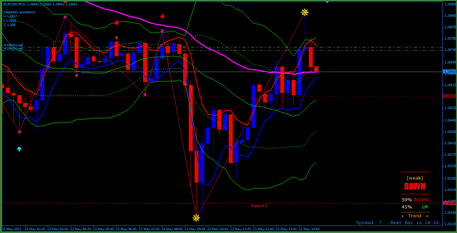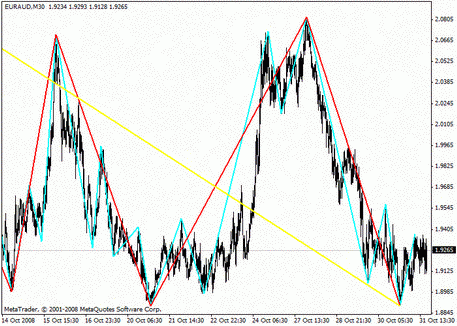
Support and Resistance Lines
Saturday, 22 July 2017 21:23
Lines of support and resistance are very important in the Forex trading. These lines are the levels that traders psychologically consider as profitable for making deals.
- A line that price cannot break from the bottom to top, is called a resistance line. This is a place where bears (sellers) enter the market. Their number is growing, until the price growth stops. If they managed to stop the price, then most likely, they will go to the market in the same place again, dropping it down. This makes the resistance level a convenient point for opening the short-term deals, or for the take profits of the long positions;
- A limit that cannot be broken from top to bottom is called a support line. This is a place where bulls (buyers) enter the market. Their goal is to stop the price drop, and make it grow again. Just like in the first case, a level is formed, which the price cannot break through. Support lines are used to open the long positions, and withdraw profits from the short ones.
Since many traders around the world open the deals at the same points on the chart simultaneously, the price line reaches this invisible limit, and rolls back after the collision. Obviously, such levels are not the straight lines, mathematically. During the trading, you can see how the value goes slightly over the designated border, or rolls away from it, even before crossing. Therefore, it’s worth remembering that, in fact, there are not lines on the market, but zones of resistance and support.
Breakthrough
While the market is in the state of a flat, the value can move within such boundaries for long. However, when bears or bulls get a significant advantage, the cost line breaks through the level. For example, if there are more bulls on the market, the price breaks the resistance line, and starts moving up.

Usually, after that, the value of the asset will return to its previous value again, to roll back, and continue to grow. Thus, the resistance limit becomes a level of support. Similarly, the value of the lines changes with the formation of a bearish, downward trend.
It’s worth noting that the price starts moving faster after breaking through such levels. The fact is that traders set the stop loss orders outside. Each order of this type is executed in the direction opposite to the transaction. If the market participant opened the sale deal, the stop loss will work as a purchase, and vice versa. Thus, all the orders begin to be executed massively, which further pushes the value of the asset towards a new trend.
This feature of the market is often used by market makers who want to get rid of the unnecessary players. Using big amounts of money, they push the price to the points of the stop order accumulation, after which they trigger, and the trend intensifies.
Application in Trade
The described levels play a key role in searching the entry and exit points. Typically, support levels are used to open the long positions. After a collision with it, the price will move up and the trader will receive a profit. Stop loss is placed under the support zone.
Similarly, the resistance is used for the short positions, with the stop loss above.
False Breakdown
The main risk of such a type of Forex trading is to understand whether it’s a true breakdown, or not. That's why traders use a lot of additional tools of technical analysis, checking their indications with each other.
Different instruments and different traders see the levels in different ways. In fact, there are always a lot of points on the market, where a price turn is possible. To find out the most significant levels, different strategies and indicators are used.
Sometimes you can see how the price breaks through a support or resistance level, but after a while, breaks it again in the opposite direction, and continues to move within the limits of the previous range. In this situation, a lot of traders can get losses.
To protect your trade, wait until the price will test the level again. You need to make sure that the resistance turned into support, or vice versa.
Share
Related articles
- Previous article: Patterns on Forex - Application in Trade
- Next article: The Best Technical Indicators on the Forex Market

 English
English
 русский
русский





